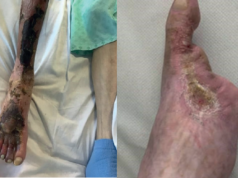
The opening of an outpatient wound centre has been associated with a significant increase in peripheral vascular practice and a significant decrease in amputation rate. Venita Chandra and colleagues Alyssa M Flores, Matthew W Mell and Ronald L Dalman (Stanford University, Stanford, USA) believe that such centres result in synergistic systems that promote more aggressive and effective limb salvage strategies. Chandra presented the findings of a recent study analysing the clinical impact of a wound care centre on a vascular surgery practice, at the Society for Vascular Surgery’s Vascular Annual Meeting (VAM; 20–23 June, Boston, USA).
According to Chandra, chronic wounds remain a growing problem, not only in the USA but worldwide—with many patients at risk of limb loss presenting as particularly challenging. This cohort requires complex and resource-intensive medical care, reported Chandra.
World experts and leaders in this specialty have developed and described programs to attempt to improve the care of these complex patients and decrease the risk of amputation, all of which involve multidisciplinary approaches. Chandra provided an example of such a programme, outlined initially by Joseph L Mills (Baylor College of Medicine, Houston, USA) who described an in-hospital based limb salvage programme, involving both podiatry and vascular surgery. This programme demonstrated an impact in terms of a significant decrease in major amputation rates, as well as an increase in the number of vascular procedures. A key component to these multidisciplinary models and the care of these chronic wound patients, Chandra noted, is wound care itself.
Would care centres with multidisciplinary teams that provide weekly standardised wound care, including debridement, offloading, oedema and fluid management, have been demonstrated to make an impact in terms of wound healing and amputation rates. However, Chandra noted the problem with these wound care centres, as they can be difficult to manage, and cost-prohibitive.
She therefore stated that one consideration when developing a wound care centre would be the down-stream revenue potential, and practice-building possibilities brought on to the affiliated hospital and vascular surgery practice. For example, patients taken care of by vascular surgeons in clinics would be sent to a wound centre for standard of care, regular wound management, which has been shown to have a significant impact. Chandra said that if the system works, they hope it will attract local and regional attention, as well as increasing referrals to the centre.
Chandra’s affiliated institution—Stanford University School of Medicine—opened an outpatient wound centre in 2013, with four rooms and two hyperbaric chambers; uniquely staffed by 50% vascular surgeons and 50% plastic surgeons, along with infectious disease specialists for on-site assessment of clinically infected wounds. Chandra and colleagues then carried out a study to assess the impact of the opening of an outpatient wound centre on the practice patterns of tertiary care vascular surgical practice.
The authors performed a retrospective review of a prospectively maintained database of vascular surgery cases and compared the three-year period before the wound centre opened the period immediately after its opening. They included patients that underwent revascularisations, debridements and amputations, and excluded trauma and acute limb ischaemia. They supplemented their data with extensive chart review and the social security death index.
Regarding the volume of procedures, 662 procedures were identified before the wound centre opened, and 1,085 procedures afterwards that met the criteria.
A rather interesting and key finding was that there was a disproportional increase in peripheral practice—with a 64% increase in volume of lower extremity interventions. These interventions initially comprised 19% of the practice before the wound centre opened, and then increased to 26% of the practice after the wound centre opened: a statistically significant difference.
In relation to patient characteristics, Chandra referred to data demonstrating that other than the increase in patients and limbs cared for, there was no difference in terms of age, sex and comorbidities that were cared for—showing that the same type, and demographics of patients were being treated. However, there was a significant difference in the number of patients who had wounds (39% before the wound centre opened, and 45% after, p=0.05).
Data regarding the surgical indications conveyed that while the absolute number of procedures for every indication went up after the opening of the wound centre, the proportion of patients treated for claudication decreased from 36% to 30% (p=0.02). Additionally, the proportion of patients treated for diabetic foot wounds significantly increased from 12% to 17%, (p=0.007). No differences were seen in the types of revascularisation procedures performed between cohorts, although there was an increase in surgical debridements and endovascular infrapopliteal interventions in the period after the centre had opened.
The authors performed a multivariable adjusted analysis and found that treatment after the wound center opened was associated with a significant reduction in risk of major amputation, compared to before (HR: 0.38, p<0.001). A similar analysis was also carried out for mortality, but this did not show any significant benefit (HR: 1.10, p=0.6).
Chandra concluded by reiterating that the opening of an outpatient wound centre was associated with a significant increase in peripheral vascular practice and a significant decrease in amputation rates. Chandra and her team also believe that having vascular surgeons embedded within wound centres results in synergistic systems that promotes more aggressive and effective limb salvage strategies.













